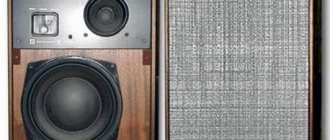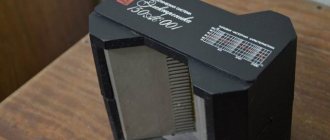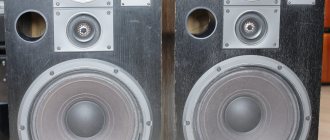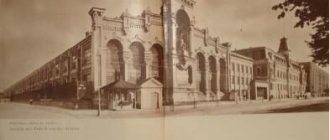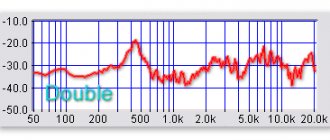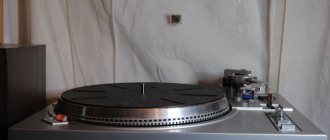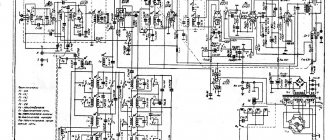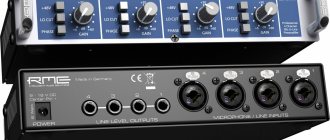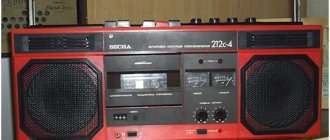Soviet HI-FI and its creators: Levitsky’s path and “planars” in the USSR
Continuing the series about the legends of Soviet sound, I wanted to separately touch on the topic of isodynamic headphones created in the Land of the Soviets. Today, many are convinced that planar magnetic technology (isodynamic sound wave radiation) is a product of modern developments. There is some truth in such judgments (the materials have changed), however, the principles themselves are not new at all and have been actively used to create audio equipment over the past 40 years.
The authorship of “unique” technologies, with the light hand of marketers, is attributed either to the Japanese, or to the Chinese, or to some “mysterious” engineers from the USA. It is not uncommon that, when starting to use not very common isodynamic drivers, manufacturers position their products as something completely new, never used before. As it turned out, not everyone knows that isodynamic emitters have been produced for quite a long time, and at one time they were widely used in Soviet audio equipment.
Fathers of Soviet isodynamics
Engineer Igor Levitsky and his colleagues from the Lvov Research Institute of BREA are deservedly considered the creators of the most famous Soviet isodynamic drivers, as well as devices based on them. It was they who developed the legendary isodynamic headphones under the Amfiton brand TDS-7, TDS-15, TDS-21, N-25S (TDS-25). Today Levitsky heads the development department of the international corporation OPPO Digital, where he also creates headphones and speaker systems.
Levitsky in Oppo Digital photo whathifi.com
Having graduated from the electroacoustic department of the Kiev Polytechnic Institute, the talented young engineer Igor Levitsky decided to connect his professional aspirations with the Lviv Research Institute of Household Radio-Electronic Equipment (BREA Research Institute). As Levitsky himself stated, he was impressed by the sound of the Japanese JVC Zero 5 acoustics with Matsushita ribbon drivers, which largely influenced the choice of topics for research and projects.
At that time, Soviet industry was striving to catch up and overtake the West, so the USSR Chamber of Commerce and Industry purchased samples of Western technology and sent them to Soviet research institutes for study, and in some cases, copying. After a detailed study of the acoustic systems of Japanese developers, Levitsky began hard work on the creation of new emitters in the sector that was developing speakers and headphones.
TDS-7 - the first-born of the BREA Research Institute
At the time Levitsky arrived at the BREA Research Institute, the sector had already completed the creation of TDS-7 - the first Soviet isodynamic headphones. Among all headphones of this type in the USSR, they were the most popular, and were mass-produced from 1980 to 1990. For some time, these headphones were considered one of the best in the country. At that time, they had acoustic characteristics almost unattainable for traditional electrodynamic counterparts.
Assessing TDS-7 in an interview with whathifi.com, Levitsky noted:
“...compared to everything else that was (or rather, what was not) on the USSR market, the TDS-7 was a powerful breakthrough into the territory of high-quality sound.”
Characteristics of TDS-7:
- Reproducible frequency range: 20 -20000 Hz.
- Harmonic distortion coefficient, in the frequency range from 100 -2000 Hz - less than 1%.
- Sound pressure level at 500 Hz at 1 mW: 94 dB
- Input power: 2 mW.
- Nameplate power: 1000 mW.
- Nominal electrical resistance: 8 ohms.
- Retail price - 49 rubles, with stand - 53 rubles. 40 kopecks (half the salary of a young engineer in the 80s).
- Weight without cable: 310 g.
Another advantage of TDS-7 that was important for Soviet times was their relative accessibility for the average buyer, in other words, “availability.” At the same time, TDS-7 was not without its shortcomings. Their main disadvantage was ergonomics. An hour spent in a headband that puts pressure on the ears with hard ear pads will seem like a disproportionate price to pay for good sound for users of modern technology. But harsh Soviet music lovers tolerated even worse things.
TDS-15 - descendant of the famous Japanese
Having assessed all the advantages and disadvantages of the TDS-7, Levitsky understands that his colleagues made a big leap in terms of fidelity, but forgot about ergonomics and design.
Hard ear pads, a pressing headband and a rectangular shape of the headphones turned listening into a sophisticated voluntary torture. The sector's leadership also recognized the need to create a more advanced model. So, with the active participation of Levitsky, work began on the creation of Amphiton TDS-15 headphones. As the basis for the new development, they chose not just anything, but the Japanese high-end development Sansui SS-100. Having analyzed the key disadvantages of the TDS-7 and the advantages of the Japanese analogue, the engineer proposed making an open supra-aural acoustic design, which significantly improved the sound compared to semi-closed predecessors.
In addition, the development team proposed a round shape of the membrane and headphones, which improved ergonomics and did not negatively affect the sound. These decisions also had a positive impact on aesthetics, bringing the design of the new development closer to the best Western designs. The BREA Research Institute with its TDS-15 raised the bar for quality, design and ergonomics to the skies, becoming the new standard of Soviet HI-FI. Serial production of TDS-15 began in the mid-80s at two enterprises at once: the Schetmash Production Association in Chisinau and the Leningrad NPO Ferrit (Magneton plant).
Characteristics of TDS-15:
- Driver type: isodynamic.
- Type of acoustic design: open (the bowls lie on the ears, and do not wrap around the ears).
- Resistance: 16 Ohm.
- Sound pressure level at a frequency of 500 Hz at 1 mW: 94 dB.
- Frequency range: 20-20,000 Hz (+3/-3).
- Rated power: 2 mW.
- Nameplate power: 1000 mW.
- Weight without cable: 300 g.
- The retail price of 50 rubles (for comparison, the original from Sansui SS-100 at that time cost about $300) did not frighten lovers of good sound, but it was extremely difficult to find these headphones on the open market.
Celebration of N-21S portability
The pinnacle of ergonomics and design sophistication among Soviet isodynamic headphones was the TDS-21 (N-21S). They became Levitsky's first development with soft foam ear pads. Serial production of headphones began in 1989. The headband of the headphones folded, which made the device very compact.
Due to its light weight, compactness and foam ear pads, the N-21C quickly won over a young audience of users of the cassette players that were fashionable at that time.
Characteristics of N-21S:
- Frequency range: 20-20,000 Hz.
- Resistance: 32 Ohm.
- Sound pressure level at a frequency of 500 Hz at 1 mW: 97 dB.
- Nameplate power: 500 mW.
- Dimensions: 220*205*60 mm.
- Weight without cable: 120 g.
- Retail price: 35 rub.
Amphiton N-25S – the swan song of Lviv engineers
Just before the end of the Soviet era, Levitsky and the team from his sector managed to develop the last isodynamic headphones created in the USSR - the Amfiton N-25S. This development is almost completely free from the “childhood diseases” of TDS-7, and meets all the requirements of the time.
Work on the headphones was completed in 1990. Serial production lasts just over two years. The collapse of the union and privatization almost completely destroy the possibilities for the production of such equipment.
Characteristics of H-25C:
- Resistance: 32 Ohm.
- Maximum rated power: 0.1 W.
- Harmonic distortion coefficient, in the frequency range from 100 -2000 Hz: less than 0.6%.
- Frequency range: 20-20000 Hz
- Sound pressure level at 500 Hz at 1 mW: 98 dB.
- Connector: 3.5 mm (6.3 mm adapter included).
- Weight: 200 g.
- Price: market (by the time mass production was launched in the territory of the former USSR, fixed prices ceased to exist)
The developments of the BREA Research Institute, their theoretical basis and practical experience were carefully studied at other enterprises of the USSR.
This made it possible, in a short period, to create and launch the production of several models of isodynamic headphones, not directly related to the Lviv Institute. Below is probably not a complete list of isodynamic headphone models produced in the USSR in the 80s:
Lomo (12a35), Electronics Lvov (TDS-5, TDS-5M, TDS-19, N-28S), NPO "Kvant" Kiev (TDS-16 Echo), NPO in Smela (N-16 -16 C, N-16-40 C, N-16-100 C – analogues of TDS-16 Echo).
In the 90s, engineer Levitsky left for the USA, where he first implemented his ideas at the BG Radia company, which created isodynamic acoustic systems, and then became the head of the development department at OPPO Digital Corporation, where he works to this day.
Bottom line
Soviet engineers sometimes created what today marketers in the West assign the status of innovative developments and supernova ideas. It is not surprising that many of them, for example, Levitsky, Voishvillo, Shushurin, are now successfully working outside the former Union. Perhaps, through the efforts of these enthusiasts, the industry of the Country of Soviets would be ahead of the “decaying West” in the technology race and would give citizens world-class products. But, alas, history does not know the subjunctive mood. The era of Soviet triumphs sank into oblivion along with the collapsed country, leaving only memories of the colossal potential of its scientists and engineers.
↑ The essence of the problem
In general, the headphones are comfortable in all respects, if not for one fly in the ointment.
Some time after the purchase (some have less, some have more, it doesn’t happen every time) miracles began to happen. The sound would periodically disappear, first in one channel, then in another. Moreover, if you pull out and then insert the plug, the sound is restored for a while. It was possible to restore sound by pressing on the appropriate ear or even shaking your head. If anyone figured out how to take them apart, then, as a rule, they discovered a completely normal-looking soldering joint. Sometimes there was a torn wire in the plug, but more about that below. And resoldering it did not solve the problem. Therefore, they usually began to sin on the speakers and the device was sent to that very closet. Or thrown away. An alternative option is to give it to children and play pilots.
↑ Postscript with plug
From the factory, the TDS-3 comes with a currently unpopular 5-DIN connector. You can solder a plug suitable for the most common connection option. In my case it is a 3.5″ jack.
Inexpensive plugs of unknown origin may work normally for some time, and then, due to the unreliability of the design, something similar to what was described at the beginning of the article begins.
Disassembly usually shows poor contact between the leads and the riveted contact tabs. By the way, a good version of a plug can be made in a hurry if you cut off the plastic from the non-separable jack from the dead headphones of some player. We get the following part in which there are no mechanical connections with contact petals:
You can solder the wires and form a “case” with heat shrink tubing or wrapping everything with electrical tape. This option served me flawlessly for several years, despite its terrible appearance.
The wires that come with most of the current consumer goods headphones, although they differ in design from those described above, are no better in quality. And the same problems occur.
I hope my article will be useful for beginners or bring back warm memories for luminaries. Thank you for your attention!
↑ Let's look further
And this time, disassembly was carried out with the aim of replacing the “inter-ear” wires, which are exactly the same type as on the input cable. To do this, both “ears” are unsoldered and put aside until better times:
And the disassembly of the fastenings on the bow begins:
one screw (on the right) and two M2 bolts (on the left) are unscrewed. After this, the outer cover is removed. Then another “dual” bolt is unscrewed, which also holds the “head size” adjuster spring. Unlike the previous ones, it fits a straight screwdriver, more familiar to Soviet radio equipment:
The main thing is not to lose the nut located on the back side. I don’t know where, but in our area threaded products smaller than M5 are in short supply. Especially the nuts. And an extra bolt or nut on an M2 is something of a legend.
In the old Tedees, the thread of one bolt or nut was stripped from birth. Therefore, I had to pervert it with a replacement for “troika”. I wouldn't wish it on my enemy. As a result, we get a “bare” bow with the ends of the cable sticking out at the edges. We pull on one of the ends and pull it out into the light of day:
Now there are two ways. The first is to insert a piece of the Chinese audio cable mentioned above into the vacated “tunnel”. For some reason I didn't want to. Therefore, I chose “plan B”. I disassembled the old cable into its components - PVC tube and wires.
And then I charged the tube with two suitable pieces of ordinary mounting wire. And returned the resulting cable to its place. During the existence of amateur radio, many ways of threading “camels through the eyes of a needle” have been invented. Therefore, I will refrain from describing the process in detail and will show the result:
↑ Puzzle with disassembly
And in most cases the problem is easily solved.
Several years ago, exactly the same “ears” were restored. And recently I got another one, and with the same problems. So I had to go all the way over again. To begin, unhook each ear from its mounting on the earpiece:
And we take out these parts by prying them off with a knife, screwdriver or something else:
After this, the “ear” can be easily disassembled into two parts:
After this, you can unsolder the input cable and carefully look at its ends. Here is the end to which the plug is soldered:
↑ Total
Reassembly occurs exactly the opposite. Before final assembly, you can once again admire the speakers used in the design:
And after assembly we get good working headphones. At least in terms of price-quality ratio. Yes, it used to be that their purchase would punch a hole in the budget comparable to a week of luxury living for a poor student. Well, or two weeks of life as usual (half a scholarship, after all). And now you can get these for free if you’re lucky.

